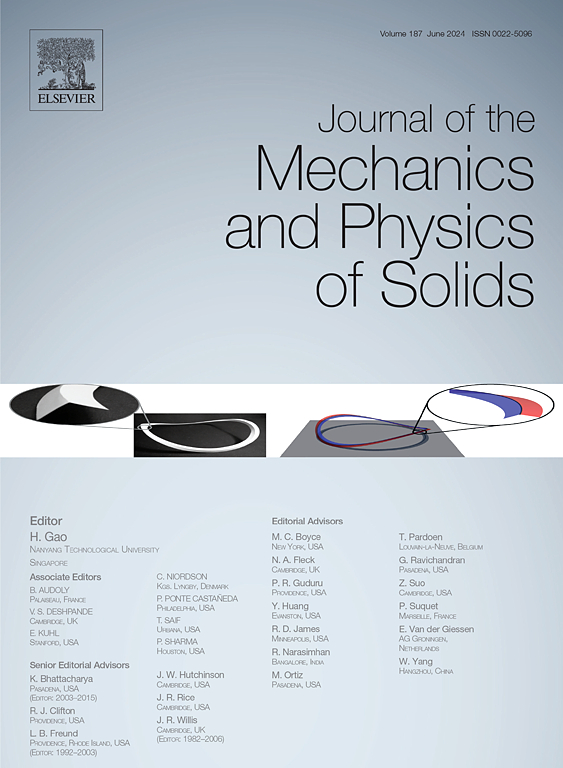Torsion-mediated instabilities in confined elastic layers
IF 5
2区 工程技术
Q2 MATERIALS SCIENCE, MULTIDISCIPLINARY
引用次数: 0
Abstract
When a soft elastic layer confined between two rigid substrates is subjected to tensile loads, the stressed layer exhibits various modes of elastic instability that influence its mechanical response. While previous studies have primarily focused on analyzing these instabilities under normal tension, this study systematically investigates the impact of combined tension–torsion loading on the emergence of fingering and fringe instabilities. Through a combination of theoretical, experimental, and numerical analysis, we show that the application of torsion can tune the mode of instabilities in elastic layers with moderate aspect ratios. We also demonstrate that torsion controls the monotonicity of the stress–stretch relationship in elastic layers with large aspect ratios. We construct a phase diagram that delineates the mode of instability and the monotonicity of the stress–stretch curve in confined elastic layers as a function of the applied torsion angle and the sample’s aspect ratio. This work not only provides mechanistic insights into the role of torsion in stabilizing the response of confined elastic layers, but also offers a valuable tool for designing soft yet tough adhesive systems capable of withstanding complex mechanical loads.
受限弹性层中扭转介导的不稳定性
当两个刚性衬底之间的软弹性层受到拉伸载荷时,应力层表现出影响其机械响应的各种弹性不稳定模式。以往的研究主要集中在分析法向张力下的这些不稳定性,而本研究系统地研究了拉扭复合载荷对指指和条纹不稳定性的影响。通过理论、实验和数值分析的结合,我们表明,在中等纵横比的弹性层中,扭转的应用可以调整不稳定的模式。我们还证明了在大纵横比弹性层中,扭转控制着应力-拉伸关系的单调性。我们构建了一个相图,描述了受约束弹性层的不稳定模式和应力-拉伸曲线的单调性作为施加扭转角和样品长宽比的函数。这项工作不仅为扭转在稳定受限弹性层响应中的作用提供了机制见解,而且为设计能够承受复杂机械载荷的软而坚韧的粘合系统提供了有价值的工具。
本文章由计算机程序翻译,如有差异,请以英文原文为准。
求助全文
约1分钟内获得全文
求助全文
来源期刊
CiteScore
9.80
自引率
9.40%
发文量
276
审稿时长
52 days
期刊介绍:
The aim of Journal of The Mechanics and Physics of Solids is to publish research of the highest quality and of lasting significance on the mechanics of solids. The scope is broad, from fundamental concepts in mechanics to the analysis of novel phenomena and applications. Solids are interpreted broadly to include both hard and soft materials as well as natural and synthetic structures. The approach can be theoretical, experimental or computational.This research activity sits within engineering science and the allied areas of applied mathematics, materials science, bio-mechanics, applied physics, and geophysics.
The Journal was founded in 1952 by Rodney Hill, who was its Editor-in-Chief until 1968. The topics of interest to the Journal evolve with developments in the subject but its basic ethos remains the same: to publish research of the highest quality relating to the mechanics of solids. Thus, emphasis is placed on the development of fundamental concepts of mechanics and novel applications of these concepts based on theoretical, experimental or computational approaches, drawing upon the various branches of engineering science and the allied areas within applied mathematics, materials science, structural engineering, applied physics, and geophysics.
The main purpose of the Journal is to foster scientific understanding of the processes of deformation and mechanical failure of all solid materials, both technological and natural, and the connections between these processes and their underlying physical mechanisms. In this sense, the content of the Journal should reflect the current state of the discipline in analysis, experimental observation, and numerical simulation. In the interest of achieving this goal, authors are encouraged to consider the significance of their contributions for the field of mechanics and the implications of their results, in addition to describing the details of their work.

 求助内容:
求助内容: 应助结果提醒方式:
应助结果提醒方式:


